
By Vincent Loiseau.
This year, I had the opportunity to go to the Swiss IT forum(s) to meet the Green IT players in French-speaking Switzerland. And I have to admit that a round table on artificial intelligence and its ethical and environmental impact on organisations also really appealed to me.
So this is a great opportunity for me to share with you the conferences I attended. The forum took place over two days, on 26 and 27 September 2024 respectively.
There were several conference formats on the menu: Demonstration (20 minutes), Workshop (20 minutes), Conference (40 minutes), Round Table (60 minutes).
In the rest of the article, I’ll be sharing a summary of the main messages from these conferences.
Resilio Tech demonstration by Amael Parreaux-Ey (Resilio)
Resilio](https://resilio-solutions.com/fr/) is an EPFL spinoff, strongly inspired by the GreenIT.fr collective.
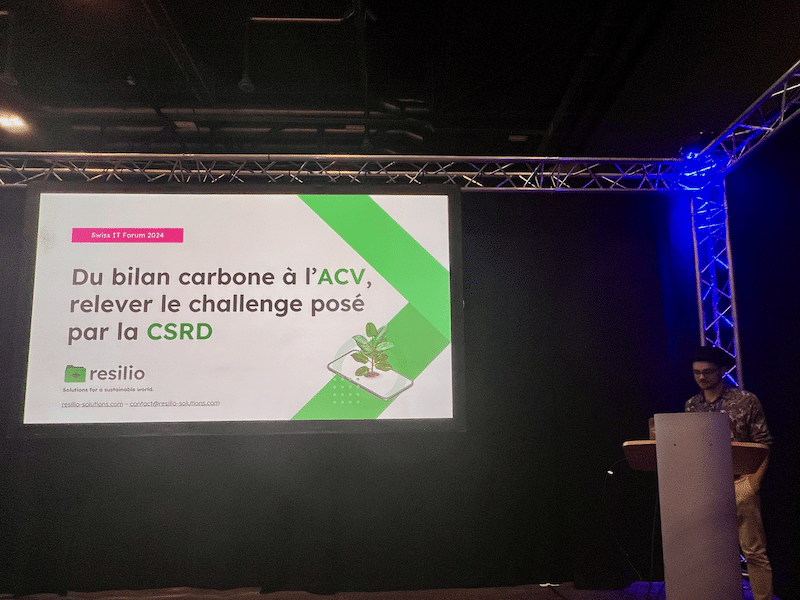
Instead of simply giving us a demonstration of the Resilio tech tool, Amael recontextualised the reason for the carbon footprint and why it should be exceeded, starting with the 9 planetary limits, 6 of which have unfortunately already been exceeded…
Amael reminded us that there are 3 priority regulations for the digital sector, which will govern the environmental declaration of companies, whether for their products, activities or suppliers:
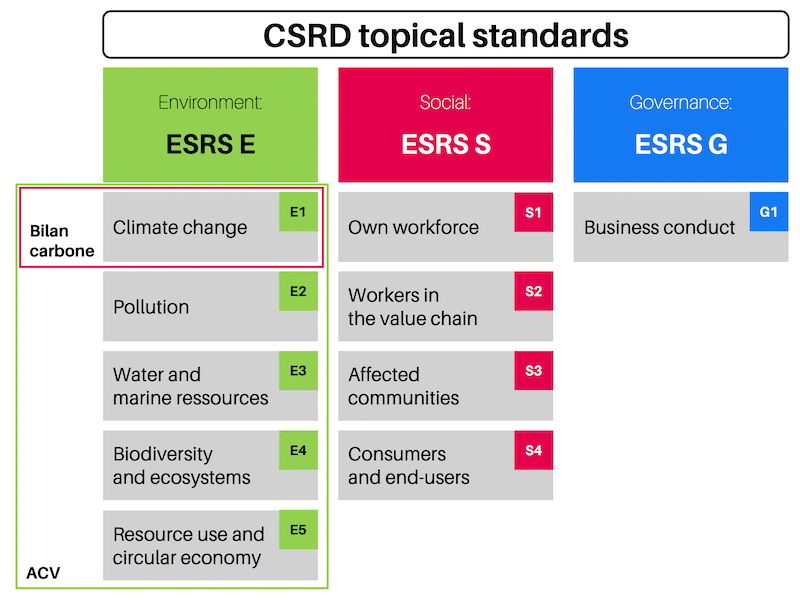
A carbon footprint only covers the climate change standard. A LCA (Life Cycle Assessment) is a holistic method covering the first 5 environmental standards.
It’s true that in France, whether it’s politicians or the media, they only talk about climate change and omit the 8 other planetary limits. This doesn’t make it any easier to understand the regulations and adopt the associated constraints.
Amael then presents Resilio’s overall LCA approach, which is divided into 4 stages:
Personally, I feel that there is one point missing from the approach described: raising employee awareness of digital responsibility, in order to make it easier and more transparent to gather data and take action once the plan has been drawn up.
Knowing Resilio, this aspect is also covered in their approach, and brilliantly so by Celine Carle-Faye, head of training and gamification at Resilio.
Once this context had been described, Amael showed us some screenshots of the Resilio tech tool, and in particular :
Finally, during the Q&A session, a very interesting question was asked about Swiss regulations: what regulations and when? Amael told us that the Federal Council launched a consultation this summer with the aim of having a federal law fully aligned with European law within 2 to 2.5 years. So that’s tomorrow!
Demonstration of CircularIT by Ivan Mariblanca Flinch (MIKUJY)
MIKUJI, formerly Canopé, based in Neuchatel, and closely linked to the Swiss association for responsible digital technology ISIT-CH, of which Ivan is the head of the scientific committee.
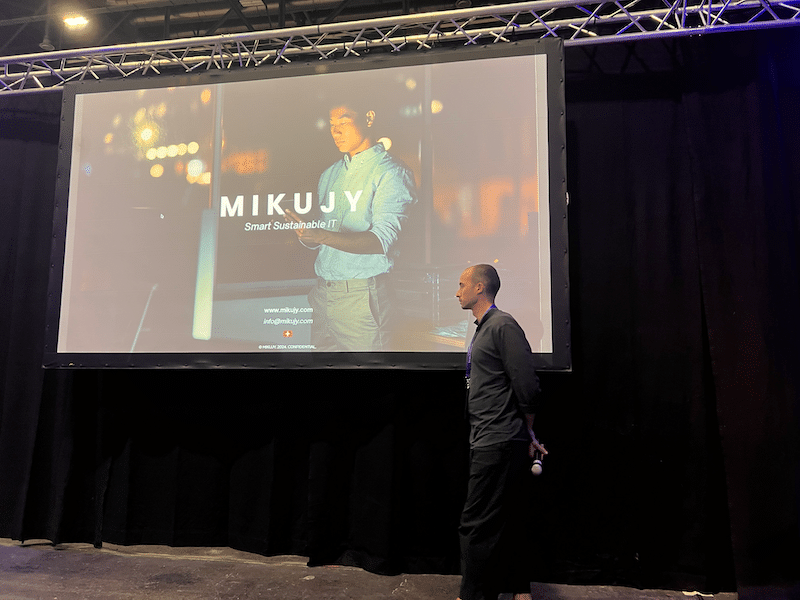
Before presenting his company, Ivan starts with a shock question:
“Do you know how long it takes on average for the carbon footprint of using a smartphone to equal the carbon footprint of building it? 346 years!”
-Ivan Mariblanca Flinch
He invites us to reflect on our irreasonable consumption of electronic equipment. What if we tried to extend the lifespan of our equipment by replacing new purchases with reconditioned ones, or by donating our old equipment that is still functional to relatives or people in need?
After this shocking question, Ivan presented his company, MIKUJY, and in particular its mission:
“We measure and help companies to reduce the carbon footprint of their information systems and support them throughout their sustainable digital journey.”
MIKUJY is unique in that it is the first Swiss company to offer an all-in-one solution with:
MIKUJY is the only company to certify organisations as digitally responsible in Switzerland (NR label from the ISIT-CH association).
To support MIKUJI’s activities, Ivan introduced us to the various modules of the CircularIT web platform.
This 1st module aims to help companies measure the environmental footprint of their information systems using the Life Cycle Assessment method.
Here too, the solution seems to make it easy to collect the inventory, either manually or automatically via an API. CircularIT’s well thought-out and polished interface makes it easy to visualise data reports and compare them with other companies already studied.
Thanks to subsidies from the OFEV (Federal Office for the Environment), MIKUJY is able to assess the environmental footprint of your IS and compare it with that of your peers, all at no cost to you! Contact them!
This module simulates the future IT footprint and provides advice for optimal decisions. It models the evolution of the environmental footprint of an IS in response, for example, to changes in the lifespan and quantity of devices. This makes it much easier to take decisions on selecting the most relevant actions to implement.
Key ambitions:
Implementing a responsible digital strategy is crucial to significantly reducing the environmental impact of digital. This module provides each department with its concrete actions to implement, facilitating and accelerating the adoption and deployment of the responsible digital strategy.
Main ambitions:
The aim of this latest module is to encourage employees to make the transition to digital responsibility by having fun through learning and taking part in interactive games.
Main ambitions:
Ivan reveals the availability of a major feature for a future version of CircularIT: measuring the impact of “Machine Learning”, a field of study in artificial intelligence aimed at giving machines the ability to learn from data and mathematical models.
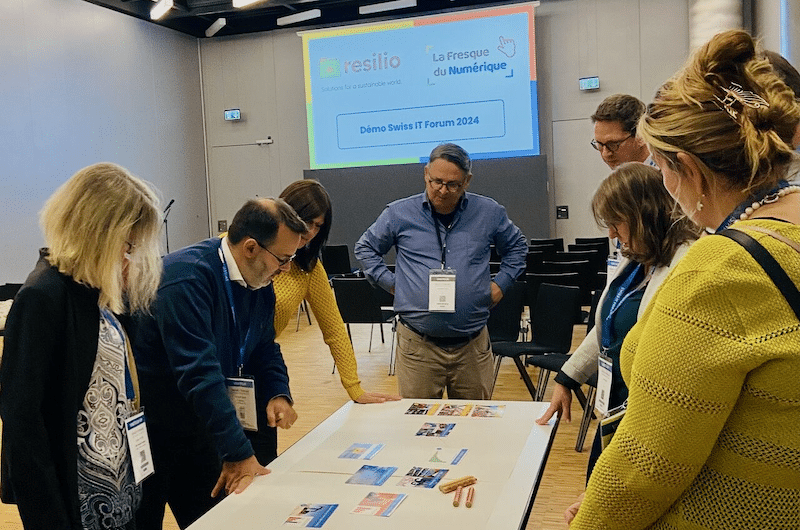
Workshop led by Celine Carle-Faye (Resilio), referent for the Digital Collage in Switzerland, and Laurent Puijalon (Redsen Consulting).
The Digital Collage is a fun, collaborative half-day workshop with a similar pedagogy to that of the Climate Fresk. The aim of this “serious game” is to raise awareness and educate participants about the environmental challenges of digital technology.
Celine took up the challenge of introducing the workshop in 20 minutes, stopwatch in hand!
After a brief explanation of the digital collage, its format and its purpose, Celine and Laurent positioned us around a table to begin the 1st stage of a digital collage: understanding the subject. To do this, the group of participants had to read out their card(s) in an intelligible voice. Then the group had to link the cards together according to the dependencies between them.
The initial cards were
We then had to position/link cards such as:
Each card included an explanation of its impact on the environment.
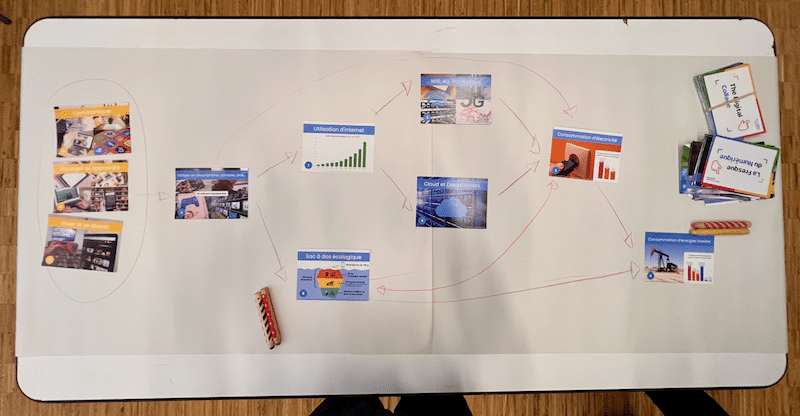
As time was very limited, Celine and Laurent gave us a quick explanation of the 3 other stages of a digital collage:
To find out more about the digital collage, I encourage you to visit the association’s official website.
Thank you to the organisers for taking up the challenge of showing us how to create a digital collage in 20 minutes. It makes you want to give it a try!
Roundtable moderated by Delphine Seitiee (Alp ICT) with Florian Revaz (ISIT-CH), Laura Tocmacov (ImpactIA) and Sylvain Rossy (AI Swiss).

Without prior introduction, Delphine turned to Florian to ask him THE question on everyone’s lips: why is Artificial Intelligence so polluting? Florian began by explaining that AI requires hardware and infrastructure. The computing power needed to train machines on mathematical models is simply phenomenal. The need is such that major manufacturers like NVidia are innovating at a frenetic pace to deliver more computing power. This comes at an ecological price: the impact on the raw materials extracted from the ground, on the water and fossil fuels used to extract and transform all this into servers.
In addition to the machines, we also have to build data centres, which also have a significant impact: cement, water for the buildings, energy and water to cool the servers, etc. Between 2022 and 2026, the energy demand for AI will double, and will be between the energy consumption of a country like Switzerland and the energy consumption of Germany! Amazon has announced a 30% increase in its water consumption due to AI. Microsoft has announced a 20% increase.
Artificial Intelligence is also a bet to solve or help us solve our environmental problems.
-Florian Revaz
Laura goes on to explain that, in fact, it’s all a question of use. And to make good use of it, we need to focus on understanding what Artificial Intelligence is, what it’s for, and what it’s not for. This will give you the awareness you need to start designing mathematical models that have as little impact as possible. So you need to get acculturated by doing your first AI project. This acculturation is essential if you are to decide to apply AI to the right use cases.
Business departments often consider that IT is a blocker in the implementation of AI within the company.
-Laura Tocmacov
Sylvain adds that there is a risk of shadow IT developing in business departments. He confirms that there are already plenty of AI projects being carried out “on the sly” in large companies. The proliferation of these projects would have an extremely negative impact on the environment.
Delphine then asked Laura about the ethical issues surrounding Artificial Intelligence, and she listed 8 interesting issues:
Delphine then asked the experts whether, in terms of generative AI, there were any models that were more ethical, more open and more transparent than the others. And incredibly, the answer was Facebook, or rather Meta! Meta has built its LLaMa project as an open-source project, open to everyone. Anyone can contribute to making it evolve. It’s completely free.
We must be vigilant to ensure that Artificial Intelligence does not supplant local digital sovereignty. Regulations are coming, and in particular the European IA Act, which will put pressure on companies in the way they manage this technology, with the possibility of very large penalties. This law is already scaring Apple, which has decided to block the use of the Artificial Intelligence embedded in the new iPhone 16 in Europe.
In Switzerland, there are plans underway for nano-taxation on the use of generative AI, so that funds can be redirected to social insurance. It will be interesting to follow this project closely!
We must be vigilant to ensure that Artificial Intelligence does not diminish our fundamental rights!
The closing sentence of this round table sums up the need for acculturation in this new technology: “Knowledge is power!”
Round table moderated by Stephanie Fontugne (Boost Partners) with Raphael Doudet (AKTIO), Benoit Chambourdon (My company CO2) and Matheo Grillet (Veracy).
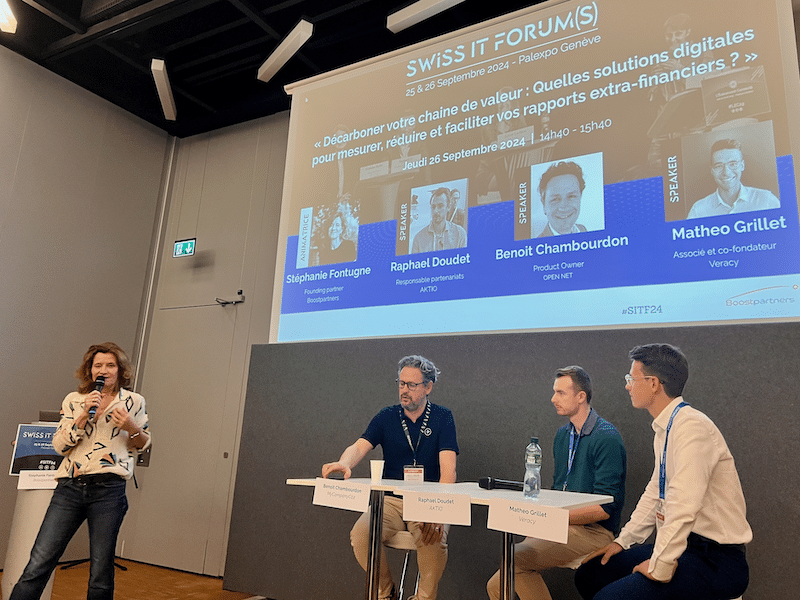
Stephanie gave us a long and interesting introduction highlighting the need to change, the need to regain control over our actions for the good of the planet we live on. I really appreciated this introduction. On the other hand, the various existing tools for decarbonising the value chain and how to choose them is a subject that is far too “tool” oriented for my liking.
However, there were three things I would take away from this round table:
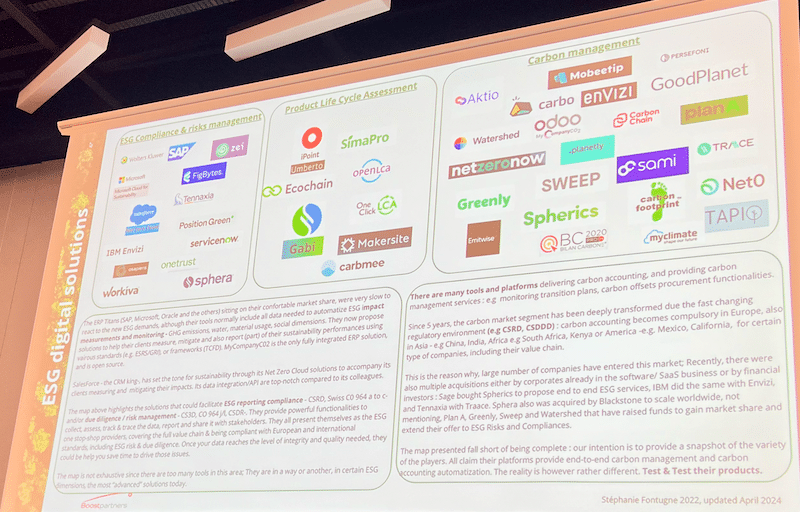
When I compare these solutions to the “niche players” in Green IT, which only measure digital impact but on many indicators other than carbon alone, I find that these publishers have fallen behind in their ability to help people make decisions and take action. Benoit was the only one who kept hammering away at this message: a good point that has engraved the name of his Odoo solution in my head.
Conference hosted by Helene Levrault from Verdikt
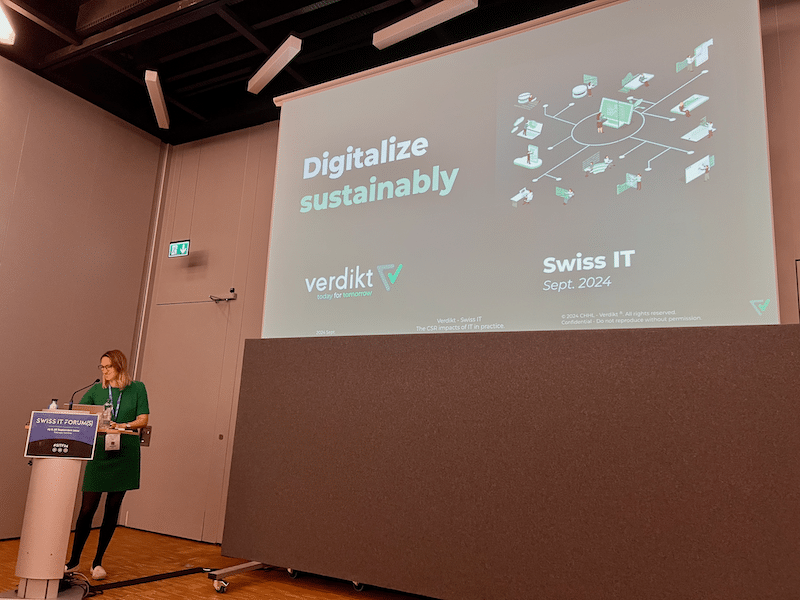
After a brief presentation of her company Verdikt, Helene would like to share three different pieces of feedback on the implementation of digital responsibility.
This large company employs over 80,000 people in more than 100 business units around the world. The company is one of the leaders in digital responsibility and is looking to improve and manage its impact far beyond carbon.
In three months, across 20 business units, with over 200,000 pieces of IT equipment and millions of Cloud usages, the company’s impact analysis showed a score of 51/100, which may not seem like much at first glance, but nevertheless places the company in the top 10% in terms of maturity, with less than 500 kg CO2 equivalent per employee.
The benefits of this maturity analysis include
The next steps for this company are
The head of the digital factory department of a company with over 160,000 employees, operating in several countries around the world, and with over 1,000 applications in its portfolio wanted to carry out a multi-dimensional audit to come up with actionable recommendations and comply with regulatory frameworks.
In 3 months, Verdikt analysed two web applications, managed by a team distributed around the world, with a total of 15,000 users per month.
The analysis of the company’s impact showed a score between 40 and 60, with one application closer to 40 and the other closer to 60. Verdikt provided around 170 recommendations to improve the environmental impact of these two applications.
Once the action plan had been implemented, the team was able to reduce the impact of its web applications by around 30%, gaining 20 points on the maturity score and moving them into the top 1%.
The next steps for the company are to:
For this third and final feedback session, Helene tells us about a CIO from a company with 50,000 employees managing 100 projects, each worth more than one million euros. The CIO wanted to evaluate and compare different scenarios across all types of projects. To do this, Verdikt assessed three pilot projects, each exceeding 5 million euros, over a period of 3 months:
The analysis provided an assessment of the projects’ carbon emissions in tCO2 equivalents, although the specific figures were not provided.
From this analysis, the company was able to introduce a new RoE (Return on Environment) KPI, which all projects must evaluate before receiving funding for launch.
On this conference, I found it interesting to see the areas where companies are focusing their efforts to reduce the environmental impact of their activities. However, I was disappointed by how these three cases were only briefly covered. It left me wanting more. I would have preferred a single, more detailed presentation, with the participation of the company involved.
Conference hosted by Estelle Veille, Lydia Allet and Thibault Couhin from Collaboration Betters The World
Lydia and Estelle presented a few practices aimed at reducing the environmental impact of projects, helping to reconcile innovation with sustainability. This list of actions is an excerpt from the eco-design checklist made available by the GreenIT.fr collective, and from Frederic Bordage‘s excellent book, “Eco-conception Web: les 115 bonnes pratiques”.
Lydia introduced the 115 eco-design levers, categorized by priority and by field:
The eco-design levers rely for two-thirds on the upstream phases of building a business process (specification, functional design, technical design). The remaining one-third is divided between two-thirds for hosting and one-third for implementation. So, eco-design is primarily not a developer’s responsibility as one might think!
CBTW recommends focusing efforts on the following points:
To achieve this, CBTW encourages:
For this, CBTW suggests:
CBTW suggests:
To explore further, I highly recommend downloading the complete checklist, buying the book “Eco-conception Web: les 115 bonnes pratiques” by Frederic Bordage, or even participating in the collective’s open-source project, whose source is available on GitHub.